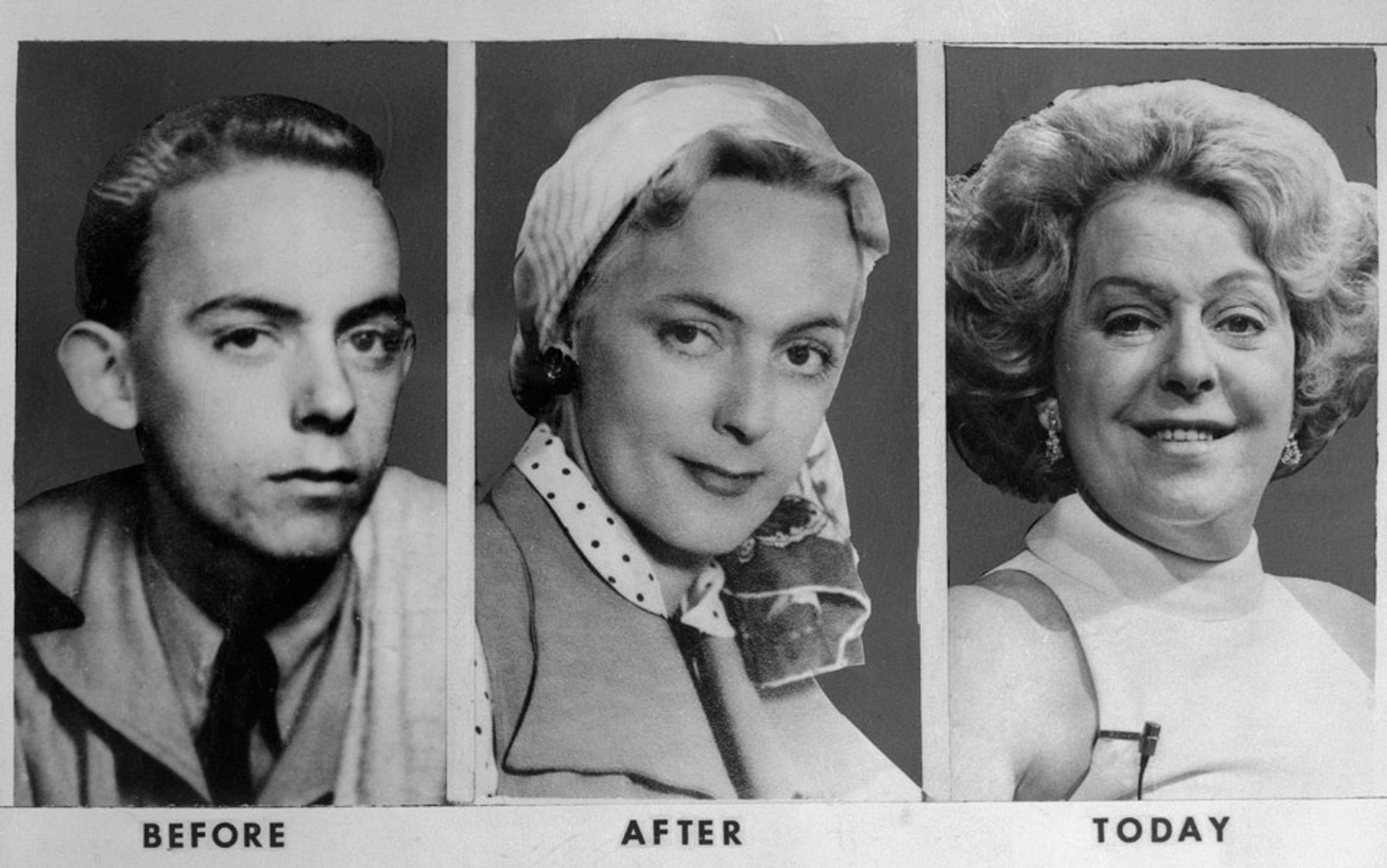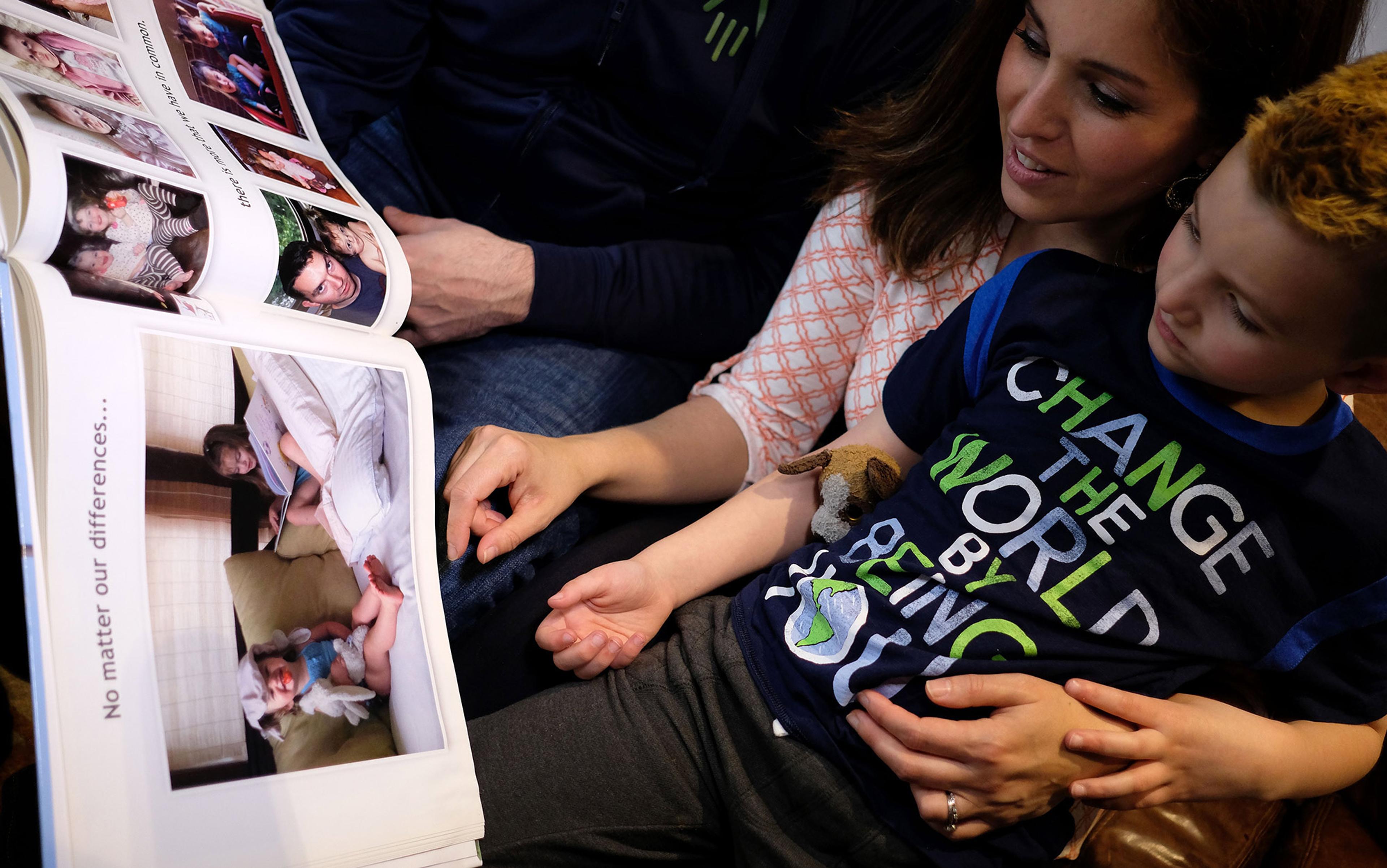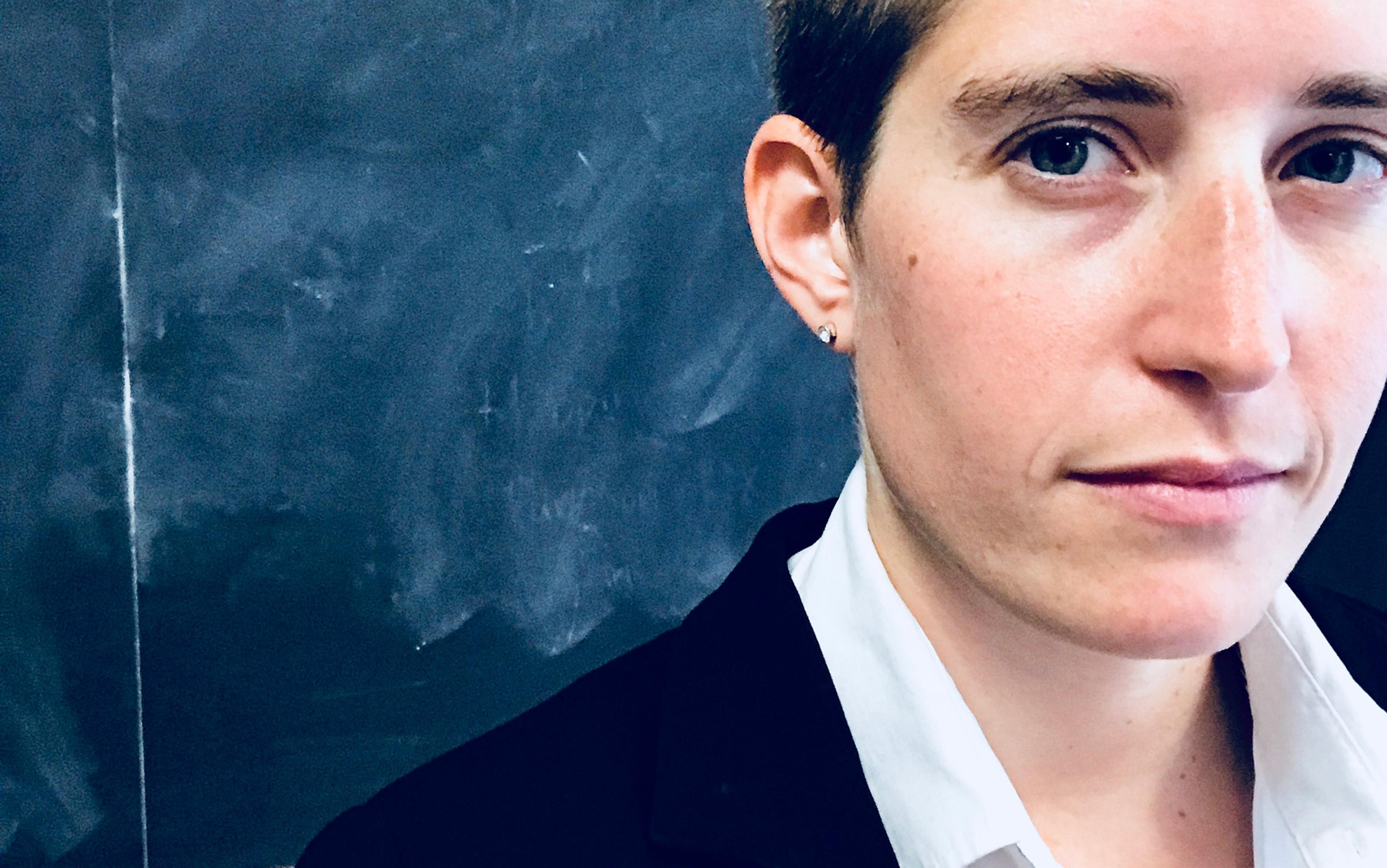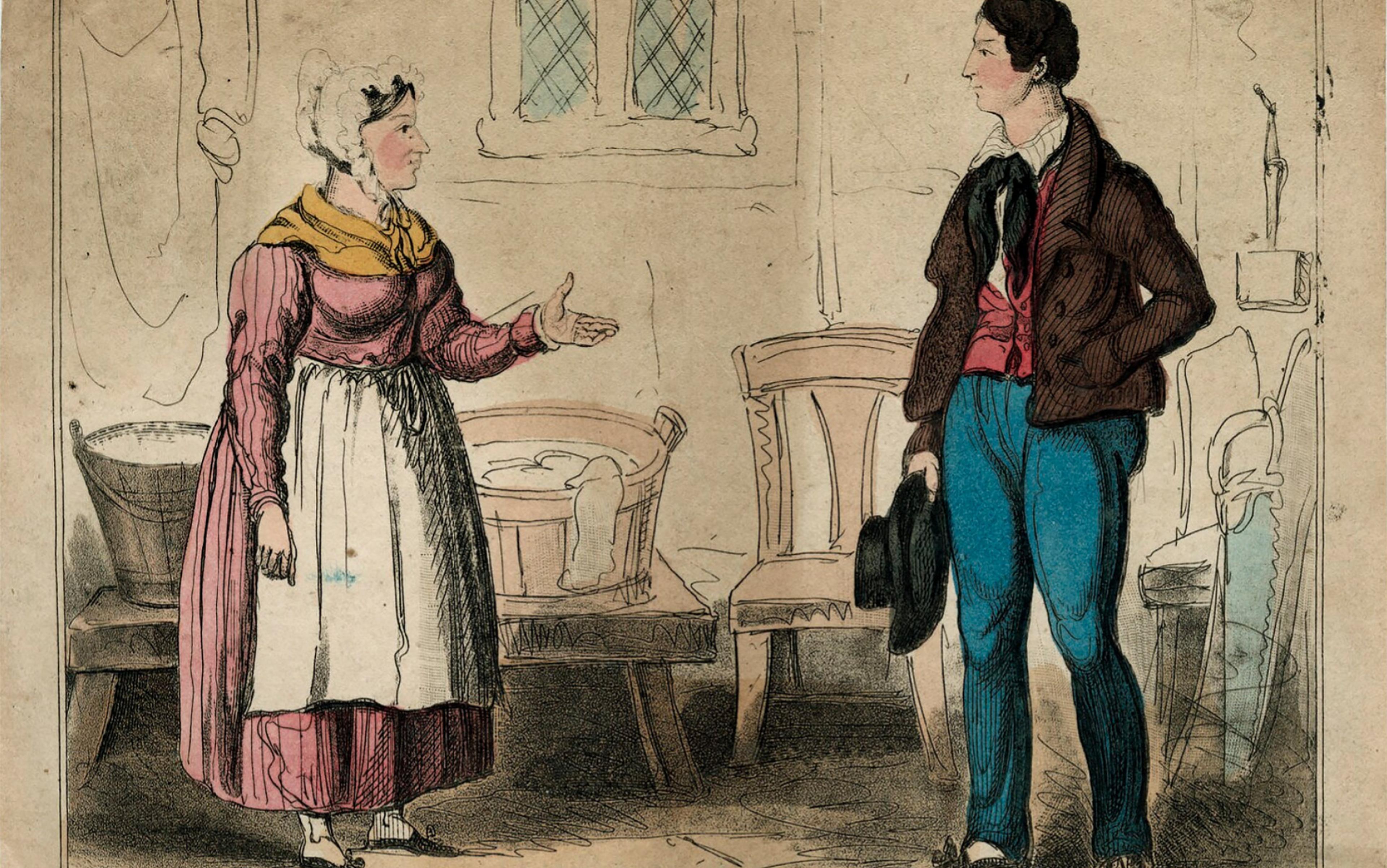Mel Wymore started taking testosterone just before menopause hit. As it turned out, he and his son went through puberty together. His son developed an Adam’s apple and a deeper voice first. ‘I trailed him,’ Mel said.
Mel, an engineer and community activist in New York City, had been divorced for nearly 10 years when he made the decision to start transitioning his appearance. ‘I sat down with the kids, and I pulled out an album of my childhood. I said: “You guys know that I’m not the typical mom because I date women, and you’ve seen me cut my hair short, and I’m discovering there is a boy inside of me that I’ve been hiding. I’m going to let that boy out.”’
Mel switched to a masculine wardrobe, restyled his hair into a traditional man’s cut, and wrapped his breasts to flatten them. ‘One of the first things I did was bind my breasts. It was such a relief to get rid of the bras and to masculate my feminine qualities.’
His children were supportive; they were 12 and 15 at the time. But Mel said they had no idea what was to come. Nor did he.
Mel, like others in the transgender community, believed with a deep-seated conviction that his female anatomy did not conform to the way he felt inside. That is not the same as sexual orientation, which is about desire. People in the trans community like to say that sexual orientation is whom you want to go to bed with; gender identity is who you go to bed as.

Mel pictured in 2017. Photo courtesy David Newkirk
According to global surveys, between 0.3 and 0.6 per cent of people worldwide consider themselves transgender. A 2016 questionnaire in the United States yielded similar results, which would give a figure of at least 1.4 million transgender adults in the US. These numbers do not take into account people who are afraid to admit how they feel. It’s no surprise that the rate of people who identify as transgender appears to be higher in places with anti-discrimination laws.
The statistics, along with a spate of media (articles, books, documentaries, and television shows with transgender characters) might give the impression that being transgender is a 21st-century creation. But accounts of men and women feeling that they were born into the wrong body have existed for centuries. In generations past, that meant changing wardrobe and adopting a new name. The rise of plastic surgery in the early 20th century allowed a few people to have operations to remove or alter unwanted organs. In 1930, for instance, the Danish painter Lili Elbe began the first of four operations that comprised castration, moulding a penis into a vagina, and implanting ovaries and a uterus. (Elbe died September 1931, shortly after the operations.)
The big difference between then and now is that hormone therapy has provided a safe means of making the physical transition complete. And it all began with the availability of testosterone in 1935 and a synthetic form of oestrogen in 1938.
On 1 December 1952, New York’s Daily News broke the story of Christine Jorgensen, formerly George Jorgensen, an introverted 26-year-old soldier from New York City who transitioned with the help of surgery and hormones. ‘Ex-GI Becomes Blonde Beauty,’ ran the banner headline. The bottom half of the page showed two photographs side by side: Christine in profile, with a short Marilyn Monroe-like bob, next to a headshot of George with a buzz cut partially covered by an army garrison cap. Jorgensen was the Caitlyn Jenner of the 1950s, which is to say that she was not the only person who underwent transgender treatment, but she was the most vocal.
In the years prior to the operation, Jorgensen considered psychoanalysis and thought about taking testosterone, an idea sparked by reading Paul de Kruif’s popular book The Male Hormone (1945). But Jorgensen didn’t believe either would change the entrenched sense of a feminine self. The book, which touted testosterone for men, got Jorgensen thinking just the opposite: ‘Could the transition to womanhood be accomplished through the magic of chemistry?’
Jorgensen duped a pharmacist into supplying oestrogen pills, even though a prescription was required, by claiming to be a medical assistant in training (which was true) who needed 100 oestrogen pills for an animal experiment (which wasn’t true). The label said: ‘Not to be taken without the advice of a doctor.’ She took one tablet every night. After the first week, her breasts felt tender. Jorgensen also felt more rested than ever – perhaps due to increased happiness rather than because of the drugs, she wrote years later in an autobiography.
Jorgensen returned home a media sensation, and began a career as a nightclub entertainer
Jorgensen found a sympathetic doctor in New Jersey willing to refill the prescription and monitor the effects. After about a year on the hormones, the doctor mentioned a surgeon in Sweden who did transgender surgical operations. So Jorgensen set sail for Europe, intending to spend time with relatives in Denmark before heading to Sweden. Ultimately, Jorgensen found a Danish doctor, Christian Hamburger, willing to perform the surgery at no cost. (Because it was considered experimental, it was covered by the government, and Jorgensen’s Danish parents qualified her to receive it.)
On 24 September 1951, Jorgensen had the first of three operations to remove her testicles and mould her penis into a vagina. Three months later, after the final operation, the news hit the US press.
A front-page story in the Chicago Daily Tribune said Jorgensen’s parents received a letter from their son ‘telling them how surgery and injections changed him into a normal woman’. Another article in the Austin Statesman included a telephone interview with Jorgensen. The reporter asked her if her hobbies were male or female. ‘I mean are you interested in say, needlework rather than a ball game?’ Jorgensen responded: ‘If it’s a normal female interest, then it interests me.’
Jorgensen returned home a media sensation, and began a career as a nightclub entertainer. By her own admission, she couldn’t sing or dance, but, as she described it: ‘I somehow skyrocketed from a devastating failure in Los Angeles to star status in a world-famous nightclub and my name in lights on Broadway, all in less than a year.’
Many Americans read the articles and watched Jorgensen perform with prurient fascination. Hamburger’s office in Denmark was flooded with letters from desperate foreigners requesting surgery. He referred the Americans to Harry Benjamin, an endocrinologist who specialised in issues of gender and sexuality at his offices in New York and San Francisco.
Benjamin would go on to write The Transsexual Phenomenon (1966), a landmark book that popularised the notion that transgender identity has a biological cause and is not due to psychological trauma or bad parenting, as was previously thought. He also wrote the introduction to Jorgensen’s autobiography, describing Jorgensen’s healthy, normal family with a charming mother and a father who served as the proper role model for a son. Benjamin explained that scientific evidence suggests that the feeling of being male or female is created in the brain of the developing foetus. While the details were still fuzzy, he said: ‘it is a possibility strong enough to bring the psychoanalyst’s dictum of childhood conditioning, as the only cause of transsexualism, close to dethronement’. He also distinguished between ‘transsexuals’, who want to switch gender, and ‘transvestites’, who want to dress as the other gender but do not have the conviction that they are in the wrong body. (The term ‘transsexual’ was used until it was replaced by transgender in the 1990s.)
Benjamin referred many of his patients seeking surgery to the team at the Johns Hopkins Hospital in Baltimore that had operated on intersex children. Howard Jones, the gynaecological surgeon there, was eager. Years later, he said that as soon as he read the newspaper reports about Jorgensen, he figured he could do transgender surgery if the Europeans were doing it.
Jones saw the surgery as a challenge, perfecting techniques and creating operations that were not yet in textbooks. He believed that Johns Hopkins had the ultimate team of experts to deal with the transgender population: endocrinologists, psychologists, urologists and plastic surgeons who were accustomed to working together because of their experience with babies born with ambiguous genitalia. The Johns Hopkins Gender Identity Clinic officially opened in 1966, the first transgender clinic within an established medical setting. (They had also treated a few transgender patients in the 1950s.) The Hopkins team required that patients cross-dress for two years, and pass a psychological evaluation before starting hormone therapy and surgery – a protocol that was based on assumptions rather than on scientific evidence.
Jones recalled that his wife, Georgeanna Seegar Jones, the director of reproductive endocrinology, shared his enthusiasm but worried about protesters. Her fears were for naught, and the clinic opened with little fanfare. (Fourteen years later, when the Joneses opened one of the first in-vitro fertilisation clinics in the US, protesters in Norfolk, Virginia tried to barricade the entrance.)
Many who felt that they were in the wrong body were encouraged to come to Baltimore because of the expansive view of gender proposed by John Money, a member of the Johns Hopkins team. He said that there were seven factors that moulded gender, including not just chromosomes and genital anatomy but also behaviour and sense of self. Yet at the same time, the steady flow of patients claiming to feel a gender identity different from that of their upbringing shattered one of Money’s central tenets – that gender identity is malleable before the age of 18 months. That was the thinking that prompted doctors to operate on intersex children and even switch a few baby boys with micropenises or botched circumcisions to girls before the 18-month deadline.
‘In a stack of brain images you couldn’t tell which came from a transgender person’
Nowadays, scientists appreciate that the development of the brain in the womb plays a crucial role in forming gender identity. Animal studies provide clues. A classic 1959 study showed that female rats born after testosterone had been injected into their pregnant mothers had ambiguous genitalia and went on to mount females the way that males do. But here’s what shocked the researchers: after the testosterone diminished and the females were injected with oestrogen and progesterone, the rodents continued to mount other females. This was one of the first clues suggesting a hardwiring in the brain that could not be changed by hormone treatment. However, this study, and similar ones conducted afterward, focused on mating behaviour, which is vastly different from gender identity.
‘People, even some scientists, talk about gender in animals all the time, and maybe they have gender but we have no way of knowing. What we know about animals is their sex,’ said Leslie Henderson, a professor of physiology and neurobiology at the Geisel School of Medicine at Dartmouth College in New Hampshire. Other scientists have shown that sexual behaviour in animals is relevant not only to reproduction, but can also show aggression or assert dominance. Sometimes, sex is barter for food. Therefore, Henderson added, we need to be cautious in making inferences about ‘sexual orientation’ or ‘gender identity’ from such behaviours.
Further rodent studies pointed to size differences between males and females in small regions near the hypothalamus. In humans, a specialised cluster of cells near the amygdala is nearly twice as large in men as it is in women. The same is true of another brain region near the hypothalamus. If or how these size differences impact gender identity is a mystery, and, as Henderson warns, size isn’t everything: ‘It may be something else, the neurotransmitters or the number of connections, or something different.’
Several studies have examined the brains of transgender people to see whether they accord with their gender identity or with their external sexual anatomy. In other words, would Mel’s brain look more male or more female? Most of these studies were small and weak, finding if anything the tiniest of correlations.
‘It seems pretty clear to me that there is a durable biological component,’ said Joshua Safer, Director of the Mount Sinai Center for Transgender Medicine and Surgery in New York. ‘But,’ he added, ‘we really have no clue on the specifics. The fanciest MRIs we have may show subtle differences, but give a specialist a stack of brain images and it would be impossible to know which one came from a transgender person, just as it would be tricky to tell a male from a female brain.’
The feeling that one is in the wrong body is probably the result of a host of factors, including hormones, genes and perhaps substances in the environment. And what causes transgender identity in one person might not be the same as in another.
As a child, Mel wanted to be a boy. He insisted on wearing trousers from the boy’s department, not skirts, nothing frilly. His mother cooperated. She even sewed custom shirts and pants for him to wear to school but demanded he wear a dress for picture day. His family assumed that Mel was a tomboy who would one day embrace a feminine side.
By the time Mel started high school, he wanted to fit in, so he grew his hair long and dressed like the girls. ‘Outwardly, I was very happy and gregarious and ebullient but very distant from my inner core.’ At the University of Arizona, he met the man who became his husband. ‘I felt super strongly attracted to him,’ he said. They carried on a long-distance relationship after graduation, and married in 1989.
In 1999, Mel started to believe that his growing sense of unhappiness was because he was a lesbian. The couple separated and divorced the following year, though they remained connected as friends and co-parents to their children, who were toddlers at the time. Mel’s mother struggled with his coming out, which led to a tense relationship for a few years – and he wasn’t happy with himself either. His relationships with women, although physically agreeable, were often filled with turmoil. ‘All of this time, I’m in therapy and I’m supposed to be this emancipated lesbian but I have these rocky relationships and I’m wondering why adulthood is so miserable,’ he said. ‘I started off having everything I could ever want: a career [as an engineer] no one could complain about; a perfect husband; two beautiful children. But something was really missing for me. I just kept trying to figure it out. Gender never came up in any session.’
The turning point occurred during a middle-school function. As head of the diversity committee of the Parent Teacher Association (PTA), he invited the Yes Institute, which works with educators to create safe environments that empower gay, lesbian and transgender youth, to give a talk.
‘Since I was the parent coordinator, I sat at the back of the classroom. I’m sitting there and they showed a clip from Oprah Winfrey and Barbara Walters interviewing transgender kids. One of them looked just like me when I was a kid and I’m wondering if that’s why I’m so unhappy.’
Mel registered for a weeklong seminar at the Yes Institute’s headquarters in Miami, Florida. ‘There were all of these trannies in the class, and a parade of people in various stages of transitioning, and it freaked me out. I had already come out and blown up my family. I’m thinking: “Holy shit, I’m going to do this all over again.”’
Changing the person everyone thinks you are is never easy. ‘There’s this grieving process’
Mel made his first public announcement after telling his family, with the support of his brother and two sisters. At a meeting of the community board on the Upper West Side of Manhattan, attended by at least 50 people, he made an announcement: ‘I’ve had this personal discovery and that my gender has been a source of pain for me, and I’ll be exploring what that means, and you may see me go through some changes. I don’t know where I’m going to land, but you can count on me to work hard as chair and to be open and willing to answer any questions you have regarding the transition. This is news to me as it is to you. I want your questions and I ask for your patience.’ He made a similar announcement at the next PTA meeting (he was president by then). A few people approached him and said that, though they were confused, they were happy for him.
Fortunately for Mel, he lived in a progressive neighbourhood. He got treatment from an endocrinologist who is considered one of the world’s leading experts in the treatment of transgender people. Not all transgender individuals are so lucky. Even so, changing the person everyone thinks you are is never easy. ‘There’s this grieving process,’ said Mel, like there is with any loss, even a divorce. ‘The person you loved, the person you imagined as part of your future, suddenly changes and that future disappears. Gender is so ingrained in our sense of self and social circles. You upset every aspect of your life when you transition. Shifting that will inherently cause grief.’
Mel had a double mastectomy in 2010. Shortly afterward, he started hormone therapy. First, he took medication that blocks oestrogen and accelerates menopause. Within a few months, he no longer needed the blockers because his body, like that of a postmenopausal woman, was not producing oestrogen.
‘That immediately made me feel better. My body was starting to feel like who I am. As I lost the oestrogen feeling, I was more myself,’ he said.
Next, he started rubbing testosterone gel on his chest, because the gel had a slower response time than shots. ‘I wasn’t going for the big oomph and I felt I could control my own dosing,’ he said. Still, the testosterone had a huge impact on his sexual desire.
‘I was really taken aback by how powerful testosterone was on my sex response, just like a male in puberty. Everybody, everything was a potential sex object. I banned myself from dating. I felt I wasn’t a reliable emotional being. I wanted to wait until I settled. I was literally a boy at 17 going through puberty’ – although, as Mel likes to add, he had an adult attitude with adolescent desires.
In transgender men (female-to-male appearance), testosterone therapy builds muscles, sprouts facial hair, boosts libido, and can also alter body odour. In transgender women (male-to-female appearance), oestrogen works not so much because of a direct impact on the body but because it lowers testosterone. Reduced levels of testosterone shrink muscle mass and alter fat distribution, padding the hips. Some transgender women also take anti-androgens to further diminish their testosterone level.
Doctors keep an eye on other hormone side effects. Taking testosterone increases the number of blood cells, which can increase the risk of stroke and heart attack. Oestrogen, according to a few studies, can increase the risk of depression. But Safer, the Mount Sinai endocrinologist, said that, for the most part, people are so happy with the transition that any potential mental-health effects from hormone treatment are outweighed.
Hormone therapy for transgender adults will not remove all the changes that occurred during puberty. Testosterone will not reduce breast size. Oestrogen will not reduce the size of the Adam’s apple nor turn a deep masculine voice into a higher feminine one. That’s why more doctors are now willing to treat teenagers and even begin therapy when the first signs of puberty hit. The most recent Endocrine Society guidelines, published in late 2017, say that some children younger than 16 may start hormone therapy – a change from the previous guidelines, released eight years ago, which said hormones should be initiated around the age of 16. But, experts warn, the data is lacking. No large-scale trials have tracked children for many years, monitoring side effects or collecting information on how many children who report being transgender wind up not being transgender after all.
At the same time, doctors are concerned about initiating treatment on adolescents who might decide that they don’t want to transition after all. Puberty blockers are reversible, so if children decide later that they are not transgender, they can stop the drugs and go through a delayed puberty. Some doctors have suggested keeping young adolescents on puberty blockers as long as possible until they have the maturity to appreciate the decision, but that’s complicated too. As one doctor said, it’s difficult enough to have a transgender identity, but to look like a scrawny boy dwarfed by classmates who are turning into hairy, muscular young men and curvy young women can be equally traumatic. The latest guidelines offer suggestions but, as experts (and parents) know, each child has to be considered individually. A one-size-fits-all protocol will not work.
Unlike Mel and other adults who transition after having children, adolescents must consider their potential infertility. A child designated male at birth who takes anti-androgens and oestrogen has a plummeting sperm count. Some adults have stopped taking their medication for several months to restore their fertility. Some teens might freeze sperm or eggs. But this option is not available to children who use hormone blockers at the first signs of puberty. It’s impossible to retrieve sperm from prepubescent boys and mature eggs from prepubescent girls.
A father of a teen who transitioned from male to female appearance said his child considers the start of oestrogen therapy as a birthday. A mother of another teen who is considering transitioning from female to male appearance said she hopes to delay testosterone therapy until her child is at least 20 years old, because she worries about the long-term impact. ‘Nobody can tell us the effect on the developing brain, and that scares me way more than anything else,’ she said. She added a caveat: if her child became depressed, then the benefits of hormone therapy would outweigh the unknown long-term risks.
Mel said that the testosterone gave him a surge of confidence. When he went home to visit his family, his sister told him he was acting like a ‘male asshole’. Was this because he was happier, which made him feel more confident? Or was it the testosterone? Mel isn’t sure.
More than 40 per cent of transgender people attempt suicide: 10 times the national average
During his transition, Mel was squeamish about using bathrooms designated for men. He worried about being found out, worried that he looked too feminine or transgender, particularly because he’d have to wait for a stall. Unlike ladies’ rooms, where women chat while checking themselves in the mirror, rearranging their clothing and fixing their make-up, Mel soon learned that men aren’t social urinators. ‘People pee and leave.’
‘I was quite timid about it, and once I started it took me a while because the smell of a men’s room is so oppressive and men are just so much more piggish about the condition of the restroom. I had this olfactory assault,’ said Mel.
Mel hopes he is one small player fostering a new understanding of gender. ‘The binary exists but the problem is the significance we give to it. I’d like to ghost the boxes, more blurred and less hardened in terms of the influence it has on everything that happens in your life.’
Half a century ago, when Jones helped to launch the Johns Hopkins Hospital’s gender identity clinic, he worried that patients’ expectations exceeded medical possibilities, that they expected treatment to cure their emotional angst. Today, many experts fear the opposite. They worry about the impact of no treatment. More than 40 per cent of transgender people have attempted suicide – 10 times the national average. The vast majority of those attempts were before therapy. Mel never considered himself suicidal, but he had 10 car accidents between the ages of 16 and 26. ‘It was kind of emblematic of not paying attention,’ he said, ‘driving really fast everywhere.’
Scientists might never know what triggers the incongruence between gender identity and external genitalia, but a community of activists, investigators and clinicians are working to figure out the best and most effective therapy to help with a safe transition in the most timely fashion possible.
Reprinted from ‘Aroused: The History of Hormones and How They Control Just About Everything’ by Randi Hutter Epstein Copyright © 2018 by Randi Hutter Epstein. With permission of the publisher, W W Norton & Company, Inc. All rights reserved.






